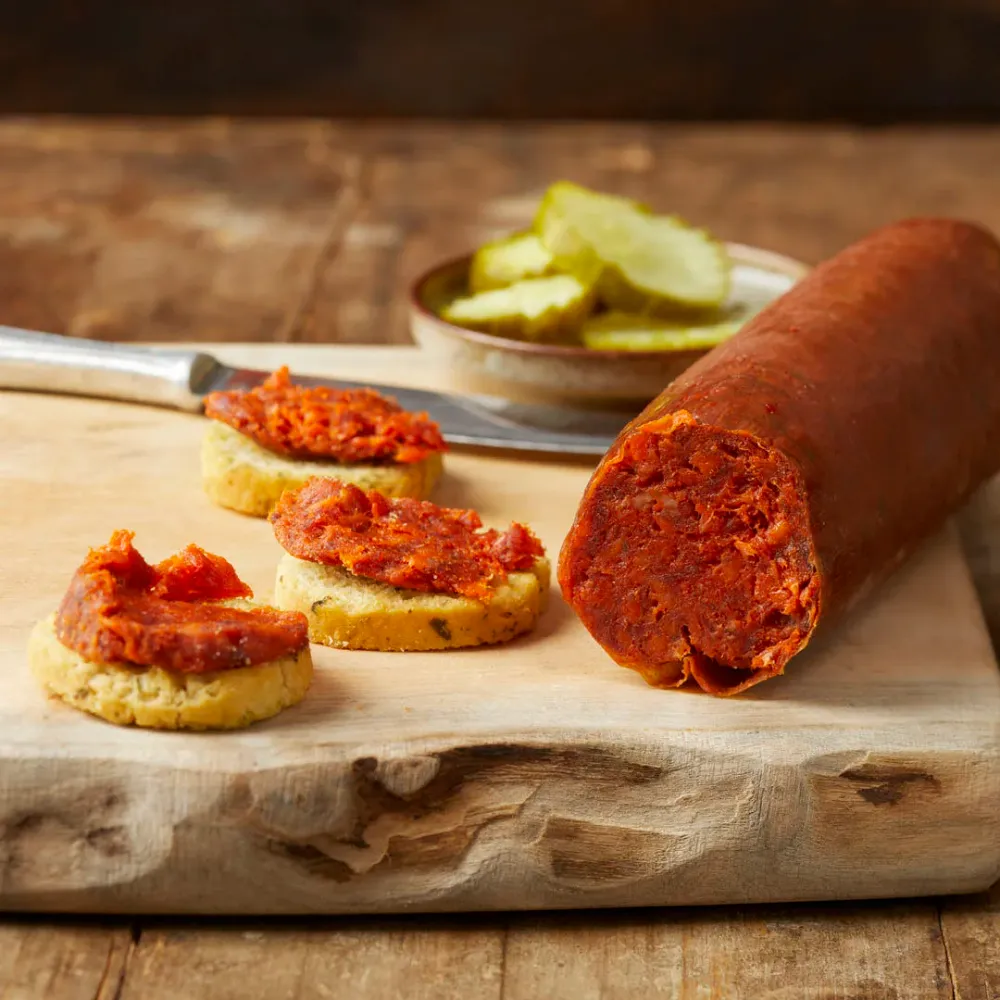Discover 'Nduja': Italy’s Bold and Zesty Spreadable Salume
As I sit here typing this, I can almost savor the tantalizing, spicy-sweet tang of 'nduja on my tongue. A single taste of this creamy, melt-in-your-mouth salume is enough to etch its flavor into your memory. Its soft texture, which practically dissolves when heated, might have subtly enhanced dishes you’ve savored before, leaving you wondering about the source of that slightly exotic, meaty flavor.
Recently, 'nduja (pronounced en-DOO-ya) has been making waves in American culinary circles, finding its way onto pizzas, into crusty bread, and blended into pasta sauces, where its vibrant red color merges seamlessly with tomatoes and fresh peppers.
The growing popularity of 'nduja has made it more accessible. A decade ago, acquiring it in the States was a bit of a challenge, often requiring a well-connected friend or a souvenir from a trip to Italy. Today, 'nduja graces the shelves of many gourmet food stores, making it easy for you to enjoy this delicacy without breaking any international laws or dining at an upscale restaurant. This is wonderful news because 'nduja offers a myriad of delightful possibilities for everyday cooking. Whether you’re just discovering 'nduja or seeking inspiration for using it in your kitchen, we’ve compiled this comprehensive guide to help you explore this Italian specialty that could revolutionize your culinary repertoire.
What Is 'Nduja?
'Nduja is a tender, spreadable fermented pork salume, laced with fiery Calabrian chiles. It hails from Spilinga, a small municipality in Calabria. The name 'nduja may remind you of the French andouille, likely due to the influence of the Angevins, who governed Calabria in the 13th century—though there are numerous theories about its origin. The sausage also shares similarities with Spanish sobrasada, possibly influenced by the Aragonese, who later ruled the region.
While the complete history of 'nduja remains somewhat elusive, we know that it emerged from a context of scarcity and necessity—a preserved pork product for those with limited means. Impoverished farmers who raised and slaughtered pigs would sell the priciest prime cuts to affluent families who could afford them. The farmers were left with a mix of offal, surplus fat, and meat trimmings from the butchering process. These scraps, known in other parts of Italy as the “quinto quarto,” or “fifth quarter,” referencing the four primal cuts of an animal, weren’t particularly appetizing on their own. However, when combined, seasoned boldly, encased, and cured for an extended period, they transformed into something truly delectable and long-lasting.
In the past, 'nduja incorporated fatty cuts of pork from the belly and back, as well as organ meat like lungs, which would otherwise be discarded. Modern 'nduja-makers may include other ingredients, but at its core, 'nduja consists of little more than ground pork, salt, and a generous helping of spicy Calabrian chiles, which lend the salume its distinctive red glow.
How Is 'Nduja Made?
To delve deeper into the art of crafting exceptional 'nduja, I got in touch with the good people at Tempesta Artisan Salumi, a family-owned, Chicago-based producer that has been making the spreadable salume for five generations, originally in Calabria, before emigrating to the American Midwest in 1970. Matt Reilly, the company's national sales director, started by explaining that 'nduja's special spreadable texture comes from its meat-to-fat makeup. Dry-cured salumi, like soppressata, typically contain a ratio of roughly three parts lean muscle to one part fat. 'Nduja inverts that ratio: Its composition is three parts fat for every one part lean muscle.
“We're using jowl. We're using the belly, the top of the shoulder. And then sometimes there's going to be leg in there,” Reilly told me. “Calabrians actually do grind the leg more often than other areas of Italy because they don't generally make prosciutto,” he adds. Prosciutto-curing requires cool temperatures and a humid environment, making its production better suited to more northern regions of Italy, like Reggio Emilia. Calabria's hot and arid environment requires a different approach to cured pork.
To make 'nduja, fatty ground pork is mixed with varying amounts of ground Calabrian chiles (roughly 30% of the total weight of the sausage) along with salt. In the most traditional Italian preparations, the mixture is stuffed into a hog middle cap—a durable portion of a pig’s large intestine, known as an orba. 'Nduja cased in orba can weigh upwards of seven pounds—more sausage than most people like to keep in their fridge at home. For that reason, 'nduja packaged for retail sale in the States is usually stuffed into smaller collagen casings.
After being cased, the salumi are then fermented in a warm, climate-controlled chamber, where they begin to take on the slightly sour flavor that distinguishes 'nduja from most other Italian salumi. “The time could be as short as maybe 12 hours. It could be as long as 36 hours,” says Reilly. “But essentially, it's somewhere around 24 hours for the acid to get up to the point it needs to, which is the most important because that's what makes 'nduja shelf-stable.” Once the 'nduja is done fermenting, the salumi is moved to a cooler chamber, where it’s hung to age for a longer period.
Traditionally, long before science offered clear guidelines on how to ensure a product remains shelf-stable, 'nduja was smoked to ward off spoilage. What was once a matter of life or death (literally) is now more a matter of flavor preference. If 'nduja is being smoked, the stuffed salumi go through that process after being fermented but before they're hung to age. You’ll find some 'nduja that has been heavily smoked, while others, like the ones made by Tempesta, aren't smoked at all.
During the aging process, as the flavor of the sausage begins to deepen, 'nduja professionals, like those at Tempesta, closely monitor the water content of the hanging salumi. A large orba-cased 'nduja can age as long as seven months, until the water activity is low enough, and acidity high enough, that the 'nduja is shelf-stable and doesn’t need to be refrigerated. Smaller 'nduja aged in commercial casings will typically be ready in four to six weeks.
While most other salumi continue to firm up the longer they are hung, 'nduja maintains its soft and pliable texture even after months of hanging. This is due to its exceptionally high fat content and the way Calabrian chiles soften and break down pork fat. As a result, these hung salumi will never become firm or sliceable at room temperature. Instead, you are left with a wonderfully spreadable salume, offering a unique funk and flavor that sets it apart from most dry-cured, sliceable salami.
On the left, a smaller smear of 'nduja, aged for less time, retains a brighter red hue. The smear of orba 'nduja on the right, having aged longer, takes on a deeper red color. While the curing time doesn’t drastically alter the texture of 'nduja as it does with other cured sausages, it does influence its flavor and appearance. 'Nduja that is hung for just a few weeks will exhibit a more vibrant paprika-like orange-red color than a longer-aged 'nduja, which assumes a more subdued, brick-red hue. These color differences are also reflected in terms of flavor: The younger sausage is brighter, with an acidic, chile-forward bite, while longer-aged 'nduja offers a mellower heat and sourness, allowing the nuanced flavors of the pork and smoke to come to the fore. Regardless, both versions are delectable.
Where to Buy 'Nduja, and How to Choose the Good Stuff
Certain Italian products and dishes—certified Pizza Napoletana, Parmigiano Reggiano, and Prosciutto di Parma, to name a few—are protected by governing bodies that ensure they adhere to certain standards, often only in the regions where they originated. This is not the case for 'nduja, although it is steeped in history and a source of great pride for those who continue to produce it. “The name 'nduja has no protection. There’s no standard for identity in America—there isn’t one in Italy, either,” says Reilly. This means you’ll have to do a bit of detective work when you’re on the hunt for a good 'nduja. Some companies will produce their “'nduja” by grinding trim and scraps from other salumi, such as prosciutto—which has its own signature dry-cured texture and flavor that is entirely different from that of 'nduja—along with more fat, and stuffing the mixture into casings. These products don’t come close to the flavor of 'nduja made following traditional methods.
So how can you discern between imitation versions and the real-deal 'nduja? Begin by examining the ingredient list. The good stuff won’t have more than three or four ingredients: pork, salt, Calabrian chiles, and in America, often lactic acid (an ingredient required by the FDA for fermented sausages; it lowers pH levels and inhibits spoilage and the growth of potentially harmful bacteria). “We don’t even add any nitrates," says Reilly of the Tempesta 'nduja. “We don’t need to. It’s already shelf-stable without us having to protect it with additional nitrates… If you were in Italy—specifically Spilinga, you wouldn’t see the lactic acid either. It would really just be the three ingredients.”
When it comes to purchasing 'nduja, you can buy it online, directly from a purveyor like Tempesta, or you can often find it at well-stocked shops that carry cured meats and cheeses, high-end grocery stores, or Italian food markets like Eataly.
To finish this marathon post, a little bit goes a long way. On bread, in soup, in pasta, on pizza... Calabian pepper powered 'nduja fills the senses with adventure.


